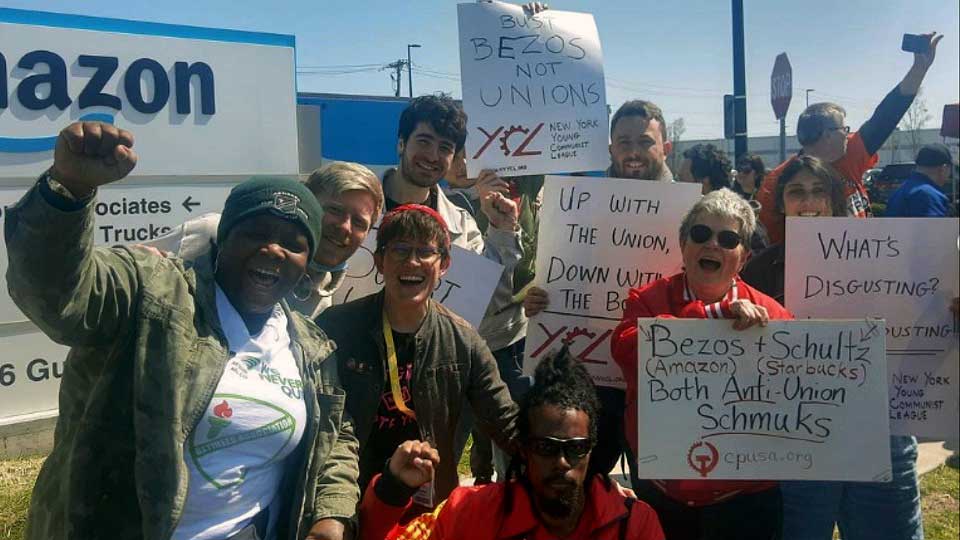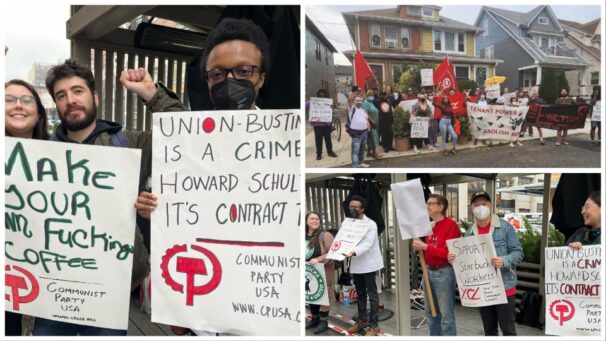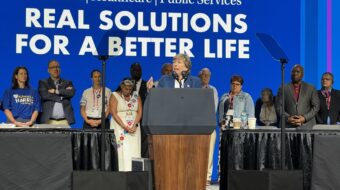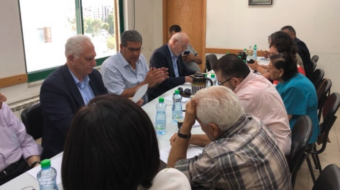
CHICAGO—“Everyone agrees that the goal in the labor movement is unity within the working class. The path to that unity is difficult, and what Marxism does is uncover and overcome the obstacles on that path to unity,” said Roberta Wood at a national gathering called by the Labor Commission of the Communist Party this week.
Wood opened a lively discussion on the history of the party’s role in the U.S. labor movement. A retired electrical worker, Wood is a longtime leader of both the Labor Commission and the party itself. In her opening remarks, she highlighted the special contributions communists must make to the movement.
She explained, for example, that uncovering the obstacles to unity in the labor movement involves utilizing scientific social analysis to map the way forward by synthesizing and combining the practical experiences of workers with theory—this helps chart the path forward to unity and then progress in solving the problems workers face.

Wood demonstrated how many ideas developed through this process eventually graduated from ideas printed in Marxist literature many years ago into commonly accepted knowledge these days. Years ago, for example, Marxists and Communists were the first to insist on Black and white unity in the movements for workers’ rights. Karl Marx, for example, talked about how “labor in the white skin will never be free while labor in the black skin is branded and enslaved.”
Today, we see within the mass movements for civil and human rights and against police violence broad acceptance of this idea. “Black and white unite and fight”—expanded to include a broad multiracial movement—is an operative slogan these days, as there is broad acceptance of what at one time was an issue raised only by Marxists and their close allies.
Wood explained how important knowledge of labor movement history is to keep the party keyed in on what’s happening today; the history isn’t just studied for its own sake, but rather as a tool to understand contemporary developments.
She received sustained applause when she told the youthful crowd of workers that the first collective labor action in the U.S. was the slave revolts. It was the general strikes of plantation workers, she noted, that signaled the death knell of the Confederacy.
A further point made was that Communists bring basic and critical facts and analysis into the labor movement.
An example is the knowledge that the U.S. produces $21 trillion every year in goods and services. Nine trillion dollars of that goes directly into the pockets of capitalists for their profits. The working class, who don’t own the means of production, make up 90% of the population. “It begs the question,” Wood said, “why don’t we just take over?”
She argued that the Communist Party is needed in the labor movement to help shine a light on the path to unity which everyone agrees is necessary. The party is needed because, in addition to having interests in common, workers are pulled apart by various contradictions. Things are set up so that workers and groups of workers compete against one another for jobs. They face enormous pressure to side with the bosses against other workers.
Marxists in general, and the CPUSA in particular, help the labor movement develop tactics needed to overcome that problem and develop the necessary unity.
Historically, the CPUSA has emphasized the importance of organizing with people in their workplaces. That is where the big profits are made, and that is where the struggle for unity must begin and must be won. Rather than focusing attention on inter-union squabbles, the party shines a light on what the key issues for workers are and how to build the unity necessary to win.
Early socialists favored “dual” unions—the establishment or rival revolutionary unions to compete with and replace mainstream unions. The Industrial Workers of the World (IWW, also known as “the Wobblies”) are a prime example. Very often, the dual unions found themselves isolated from the bulk of the workers who were left under the leadership, or better described, the mis-leadership of corrupt leaders in mainstream unions.
The CPUSA was founded in 1919 as a collective of revolutionary working-class activists that were part of a world movement. The party held and continues to hold that the working class has the key role in transforming society and that the organized labor movement therefore is a major vehicle for that struggle.
Studied Lenin
Those early Communists studied Lenin, but also through their own experiences, they tackled the tension that existed between the reactionary union leadership and the urge to leave those organizations and form dual unions. In 1920, Lenin called for Communists to work in the reactionary unions to win workers in them to more advanced positions rather than bolt and form their own competing labor organizations.
Wood referred to Left-Wing Communism: An Infantile Disorder, where Lenin wrote: “You must absolutely work wherever the masses are to be found; to refuse to work in the reactionary trade unions means leaving the insufficiently developed masses of workers under the influence of the reactionary leaders.”

“For the sake of the revolution, he called on Communists to suck it up,” Wood declared, quoting Lenin further: “You must be capable of any sacrifice, of overcoming the greatest obstacles in order to systematically and patiently carry on in those institutions—even the most reactionary—in which the proletarian masses are to be found. If you want to win the support of the masses you should not fear the difficulties, insults, and persecutions of the ‘leaders.’”
“So the goal,” Wood said, “is not to sound the most revolutionary but to develop tactics based on the assessment of what is possible.” She admitted that this can present challenges, for example, in the recent Teamsters and UPS negotiations where progress was made but much was left still to be done.
Wood explained how in the 1920s the CPUSA developed its “industrial concentration” policy, which focused on the workplaces and their surrounding communities. Members worked in industry and clubs that supported their workplace activities.
The party fought discrimination carried out through employment policies, fought for higher wages, mobilized for workplace actions, advocated union democracy and, importantly, drew strength from broader working-class movements for democracy and justice, helping make unions into champions of the entire working class.
The party worked with a Central Labor Council in Chicago, for example, to form a Stockyard Council, where they fought to open jobs to Black workers in yards in areas that were mostly populated with Eastern European workers. Community organizations from Black and immigrant groups were involved, and shop floor actions were held.
These tactics to build unity also informed the party’s struggle to build democratic unions in the 1930s; CIO unions were largely built on the basis of a steward system, election of officers, and voting on contracts. The party pushed for building labor-community coalitions and hooking up with Unemployed Councils.
It urged labor participation in struggles for civil rights in these years, particularly in the fight to free the Scottsboro Nine. It fought for Social Security, unemployment insurance, and labor rights, built the Daily Worker newspaper (today’s People’s World), and so much more. In short, the party contributed heavily to making the labor movement into a leading force in the major working-class struggles of every type.
In the wake of all these successful efforts and then the victory over fascism in World War II, the McCarthy era closed in and cast a dark shadow across the country. The Taft-Hartley Act was passed, which banned Communists from union leadership. Some 100 party leaders were indicted, and the CIO in particular was purged of its left-wing leaders.
Inherent strength
The inherent strength of the Communist Party and its close ties with the mass movements and the labor, however, helped it to survive in the decades that followed. Individual Communists continued to play key organizing and leadership roles in the labor movement and in rank-and-file organizing efforts.
In 1995, the election of John Sweeney to the leadership of the AFL-CIO ousted the reactionary George Meany business-oriented leadership. The party, along with militant trade unions, civil rights and human rights and peace organizations, not only survived but grew in strength and influence as labor opened up.

Today, the CPUSA is helping to build the changing and rising tide of struggle in the labor movement, Wood said. She described the “huge upsurge fueled by two generations of experience with student loans, police violence, immigrant rights, the 2008 economic crash, and the fight against global warming.” She said the movements of LGBTQ people were also infusing fresh energy into the labor movement.
Unprecedented levels of organizing are now going on in Amazon, Starbucks, and UPS, among many other corporate employers, while anti-communism is declining and interest in socialism is rising.
Wood said, “We remember Lenin’s words and the need for broad unity so we can channel the work of the labor movement into political action.
“Special emphasis has to be given,” she said, “to the fight against racism and keeping the fire on the bosses.” She said that fights need to be waged to control the hours of work and intensity of work and against attempts to use these issues to divide workers from one another, in particular the bosses’ attempt to discriminate against workers from other countries.
She summed up by reflecting on six challenges to labor activists:
1.) Figuring out a path to structural unity of the labor movement—bringing unions together: AFL-CIO, Change to Win, the United Electrical Workers, the National Education Association, the Amazon Labor Union, and all workers’ centers.
2.) Real union democracy to be achieved by making it possible for all workers in a workplace to be full-fledged union members, not just those whose employers have signed collective bargaining agreements.
3.) Strengthening Central Labor Councils.
4.) Building People’s World circulation and coverage in workplaces.
5.) Building the party in workplaces.
6.) Building international solidarity with unions and workers around the world.
We hope you appreciated this article. At People’s World, we believe news and information should be free and accessible to all, but we need your help. Our journalism is free of corporate influence and paywalls because we are totally reader-supported. Only you, our readers and supporters, make this possible. If you enjoy reading People’s World and the stories we bring you, please support our work by donating or becoming a monthly sustainer today. Thank you!












Comments